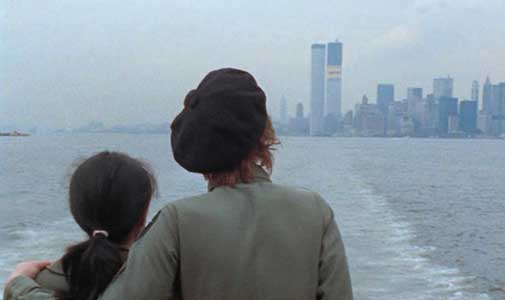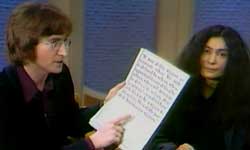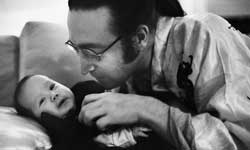
Tonight at 9 ET, the invaluable PBS arts documentary series American Masters presents its latest offering: LennoNYC, an examination of John Lennon's final, New York City years. It's not comprehensive, but it does contain some rarities and solid insights -- and whether or not you're a diehard Beatles fan, it's well worth watching. And hearing. Especially hearing, because the outtakes and acoustic versions of Lennon songs are treasures in themselves...
One image in LennoNYC is impossible to shake. We see John, his arm around Yoko Ono, alone on the back of a ferryboat leaving New York City. You can see the wake of the boat -- and if you follow the wake back to the center of the picture, your eye takes you directly to the twin towers of the World Trade Center.
John Lennon. The Twin Towers.
How New York misses them both...
Written, directed and produced by Michael Epstein, LennoNYC explains, nicely and lovingly, the city's emotional connection to the former Beatle, who arrived in New York almost immediately after the Beatles disbanded. He and Yoko set up living quarters, initially, in Greenwich Village, but eventually moved uptown to Central Park South and the Dakota.
Lennon was both charmed by New York, how it gave him the freedom to walk around and even do his own shopping, and further politicized by it. When he hit the city, the first people he contacted were Yippie activists Jerry Rubin and Abbie Hoffman. Before long, he was singing "John Sinclair" in hopes of drawing attention to that man's 10-year prison sentence for possession of two marijuana joints, and coming out with an album full of political opinions.

Presto: The Nixon White House began investigating Lennon, pushing for deportation -- and setting the stage for a multi-year battle. Also in the turbulent 1970s: John and Yoko appeared on The Dick Cavett Show, making their case for art, love, peace, and staying in Manhattan. Yoko pushed her husband away for various indiscretions, leading to his "Lost Weekend" in Los Angeles. Lennon's drug use and manic behavior hit high levels, and found an angry equal, in producer Phil Spector. And, finally, Lennon found his own level of peace as a house-husband, adoringly attending to son Sean and, just before he was murdered in 1980, recording songs for a pair of albums.
The missing pieces of this puzzle are few, but obvious. Lennon's "Lost Weekend" segment includes his newsmaking misbehavior at the Troubadour, but not that he was there to see the Smothers Brothers, or why or what he was heckling them. (Obviously, I'm sensitive to that, having written a book about Tom and Dick.) May Pang is interviewed, but her widely reported role as Lennon's mistress is underplayed completely. And as for Lennon's murder itself? Out of respect, or some other creative decision (Yoko Ono cooperated with this production), the details of the death itself are skipped over entirely.
Those are the missing links. Other links, however, are new, or rare or welcome enough to be applauded heartily. We hear from Elton John, who tells how Lennon's surprise appearance at his 1974 Madison Square Garden concert came about (and led to Lennon's reconciliation with Yoko). It was, Elton John says, "the greatest ovation I've ever heard for anybody in my whole life."

We also hear from producers and musicians who worked with Lennon on his final albums, telling sweet, small, delightful stories. How Lennon loved making music, loved the recording process... and, in story after story, loved his wife and child. (Earlier, in outtakes from the Spector sessions in Los Angeles, we hear nothing but chaos, making this documentary a clear record of personal growth.)
And, most of all, we hear the music. Not only the released versions, but outtakes ("I'm Stepping Out," "Nobody Told Me," "Beautiful Boy," "Watching the Wheels" and others), rough drafts ("Mind Games"), and acoustic versions ("Watching the Wheels," ""Whatever Gets You Through the Night" and others).
A complete acoustic version of "Watching the Wheels," in which Lennon sings about and explains his voluntary exile from the celebrity publicity machine, plays over the closing credits.
It's one final treat from a two-hour program that has offered many.